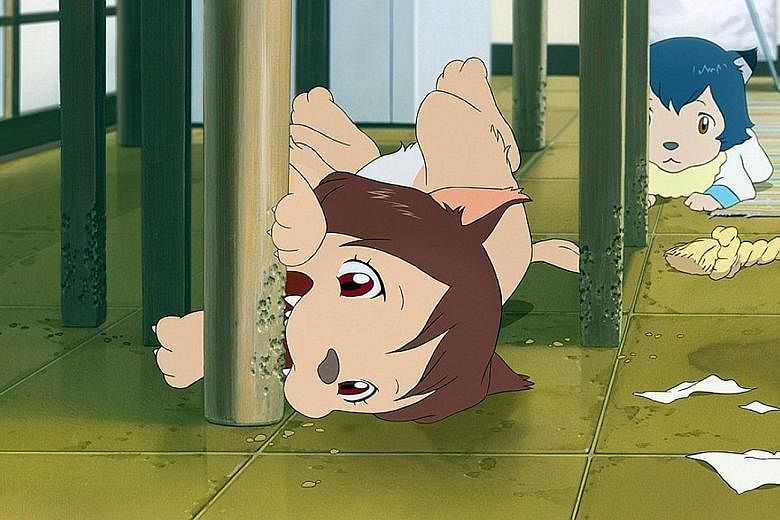NEW YORK • To much of the world, Studio Ghibli has defined Japanese animation since the 1990s, producing classics such as Hayao Miyazaki's Princess Mononoke and Isao Takahata's Grave Of The Fireflies. But those titans of the genre have not made a film in three years.
Miyazaki, 75, announced his retirement from features in 2013 and while Takahata, 80, is a producer of the coming Ghibli release The Red Turtle, he has announced no definite plans to direct more films. And Ghibli itself has not released a film in nearly two years.
Ghibli's twilight raises the question of who is to step into the breach - to be the next Miyazaki or Takahata?
Interviews with a pair of Americans versed in anime provided names that might belong on that list. But they also suggested that the question itself might be misplaced.
Mr Eric Beckman, artistic director of the New York International Children's Film Festival and president of GKids, which distributes Ghibli's films in North America, pointed out that the studio's success has not just been about Miyazaki and Takahata.
The company, which the directors founded, has provided a support system for its film-makers - larger budgets, a pool of staff animators, creative freedom - and that is unlikely to be matched.
"It's a way of producing films that I think isn't done elsewhere in Japan," he said.
"More attention could be lavished on these projects. Particular directors could see their visions through."
Mr Justin Leach, an independent producer and animator who has worked in the United States and Japanese industries, echoed the idea that Ghibli might be an impossible act to follow.
"A lot of people who enjoyed Ghibli's movies didn't necessarily enjoy the other types of Japanese animation," he said. "They kind of carved out their own niche. I'm really not quite sure if we will see another Ghibli."
Mamoru Hosoda, whose fifth feature, The Boy And The Beast, opened in the United States last Friday, is a leading contender to ascend the ranks of anime. His soulful coming-of-age films - including Wolf Children (2012) and The Girl Who Leapt Through Time (2006) - set him apart from the rest of his contemporaries, both Mr Leach and Mr Beckman said.
"He's definitely established himself among many of the people that have enjoyed Ghibli's films as sort of the central successor to that legacy," Mr Leach said. "When I saw The Girl Who Leapt Through Time, I remember thinking, this guy has something special that kind of grabs you and pulls you in."
He and Mr Beckman also mentioned Makoto Shinkai, best known for the dreamy, bittersweet love story 5 Centimeters Per Second (2007) and, like Hosoda, sometimes referred to as Miyazaki's heir apparent.
"Some of his images, of like a subway car passing, the details are so photorealistic and gorgeous," Mr Beckman said. "His skies are amazing. There's a certain patience that allows life to come through."
Mr Leach also cited Hiroyasu Ishida, still in his 20s, the director of short films such as Fumiko's Confession (2009), a Keatonesque lark in which a girl mortified by a boy's rejection runs wildly down the streets of her village.
"I feel his sensibility is very complementary to a lot of the artists at Ghibli," Mr Leach said.
Among animation studios, he singled out Polygon Pictures, whose Knights Of Sidonia was the first anime TV series acquired for first-run streaming by Netflix. And Hiromasa Yonebayashi, whose (non-scary) ghost story When Marnie Was There was the last Ghibli release, in 2014, could also be a player in the anime world.
"I'm curious to see where he goes now," Mr Leach said.
He and Mr Beckman agreed that the future of Japanese animation - and creator-driven animation in general - lies outside Japan.
Ghibli's next film, The Red Turtle, a French co-production with a Dutch director, is a case in point.
"What needs to happen to evolve to the next step is to develop these collaborations with people from different countries that find a way to reach a global audience," Mr Leach said. In that regard, he cited Daisuke Tsutsumi, a Japanese animator who worked for Pixar for years before starting his own studio, Tonko House, with another Pixar veteran, Robert Kondo.
"One thing he's really interested in doing is finding that hybrid, the best of both worlds, the West and the East," Mr Leach said. Tsutsumi and Kondo's short The Dam Keeper was nominated for an Oscar last year.
Mr Beckman's stake in the near future of anime is personal - GKids not only handles Ghibli's catalogue but also has been the North American distributor for recent Ghibli releases such as Princess Kaguya and the 1991 Takahata film, Only Yesterday, which had its American premiere last December.
Hosoda, in an interview at the Toronto International Film Festival last year, would not take the bait when asked about the post-Ghibli world. Instead, he held out hope that the Ghibli magic had not expired.
"Miyazaki-san and Takahata-san, they're not deceased," he said through a translator. "They've said that they're retiring, but because they're not dead, I believe they'll still create something."
NEW YORK TIMES

